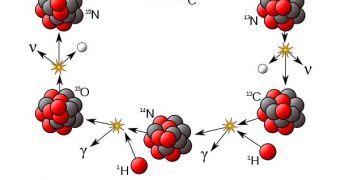One of the main problems plaguing the development of viable nuclear fusion technologies is the fact that a host of very radioactive by-products are obtained as this type of reactions take place. Granted, physicists have yet to construct the large-scale reactors that could see atomic nuclei fused together to produce energy, but they say that these hurdles need to be overcome first. A new study proposes a way to do just that. The team behind it proposes a new approach to triggering this reaction, that they say could see a lot less of the radioactive byproducts being created, NewScientist reports.
The plan is relatively straightforward – use lasers to send seismic shock wave-like disturbances through the fuel. This is precisely how the California, US-based National Ignition Facility (NIF) plans to go about doing this. Researchers here plan to begin colliding nuclei head-on in hopes of achieving fusion as early as this year. Their efforts are concentrated more on light atomic nuclei, such as the ones of helium and hydrogen. These chemicals are also the main fuels inside stars, from where the inspiration for nuclear fusion research was first drawn.
The hydrogen isotopes deuterium and tritium are to be used in the NIF reactor. They will be loaded inside a small, spherical fuel pellet, which will then be blasted with the combined radiation emitted by 192 of the most powerful lasers in the world. The pellet will be placed inside a hollow metal cylinder that will contain it as fusion begins to take place. As the experiment unfolds, temperatures will reach several million degrees in the cylinder, which will force it to emit very high energy X-rays into the pellet inside. As this happens, the fuel will get severely compressed, to about one thousandth its original volume
When this happens, its temperature increases drastically. Combined with the massive pressure, this will finally provide the necessary conditions for triggering nuclear fusion, which will see the production of vast amounts of energy, alongside quantities of the chemical compound helium-4. However, a number of neutrons will still interact with the inner walls of the reactor, therefore producing radioactive byproducts. “NIF also has to handle radioactive tritium, and this must not leak from the reactor,” explains NSF expert Heinrich Hora, who is based at the University of New South Wales, in Sydney, Australia.
He now proposes using the actual mechanical force of the laser shot itself for triggering the fusion reaction. The pulses regularly used for this type of experiments are pointed, but the scientist believes that a full-on burst of intense light could have the same effect as piercing the pellet right through. But the new approach might produce less radioactive compounds as a result, he says. Hora and his group calculated that a 60-petawatt laser shot should be enough to kick-start nuclear fusion in the NIF setup.

 14 DAY TRIAL //
14 DAY TRIAL //